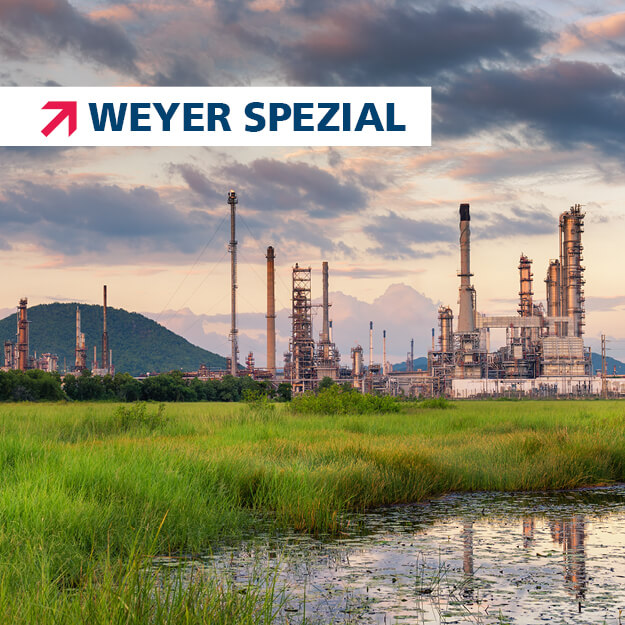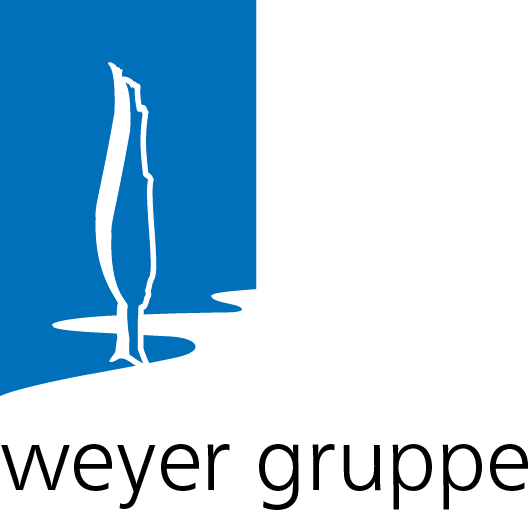Substances hazardous to water are used in practically all commercial and industrial plants – this makes water protection (according to AwSV) is an important part of a successful plant operation. Requirements for its handling are specified in numerous legal and technical regulations, such as the Federal Water Act (WHG), the Ordinance on installations for handling substances hazardous to water (AwSV) and the Technical rules for substances hazardous to water (TRwS). The application of these rules and their implementation in operational practice is a core competence of the weyer group.
- The two companies horst weyer und partner and weyer IngenieurPartner are recognised expert organisations in accordance with Sec. 52 Ordinance on installations for handling substances hazardous to water (AwSV).
Our AwSV experts perform initial and recurring inspections of SFT (“Store, Fill, Transfer”) and MTU (“Manufacture, Treat, Use”) plants as well as biogas plants based on the aforementioned requirements We develop test concepts for complex systems and create relevant expert reports and opinions on all questions relating to plant-related water protection, e.g. in the context of planning projects and approval procedures.
Water protection for plants in practice
We work with you to develop water protection concepts whose central aspect involves avoiding and detecting leaks or overfills and retaining water-polluting substances and, if applicable, firefighting water. For legacy plants, we also support you with efficient plant refurbishment and retrofitting. We also prepare all types of permit and approval applications subject to water law and operational documentation.
Services
- One-off and recurring AwSV test
- Relevant expert reports and opinions
- Water protection concepts and planning requirements
- Creation and optimization of test concepts for complex systems
- Verification of the completeness and plausibility of supplier and specialist company documentation
- Classification and delimitation of AwSV installations
- Development of renovation and retrofit concepts including a technical-economic comparison of alternatives
- Renovation and retrofit concepts for legacy systems
- Applications for approval and meetings with authorities
- AwSV operating instructions and plant register
- Classification of water-polluting substances and mixtures
- Seminars and in-house training
weyer special: Water protection
Water is essential for all life. Keeping water clean as drinking or process water and preserving aquatic ecosystems is therefore a central task of environmental protection. Plant-related water protection, i.e. the safe handling of substances hazardous to water in the industrial and commercial sector, is a core competence of the weyer group…
Download weyer special here
Frequently asked questions in plant-related water protection (AwSV)
Generally speaking, the Ordinance applies to installations for handling substances hazardous to water.
The AwSV does not apply, for example, to above-ground installations located outside protected areas and established or provisionally secured floodplains with a volume of up to 0.22 cubic metres for liquid substances or with a mass of up to 0.2 tonnes for gaseous and solid substances.
The AwSV also does not apply to
- the handling of non-water-polluting substances published in the Federal Gazette,
- non-fixed and non-stationary installations in which substances hazardous to water are handled, such as tank trucks or rail tank cars, and
- Underground storage pursuant to Section 4 (9) of the Federal Mining Act
Installations for handling substances hazardous to water are independent and stationary or stationary units in which substances hazardous to water are either stored, filled, transferred (LAU) – produced, treated or used in the commercial sector or in the sector of public facilities (HBV), as well as pipeline installations pursuant to section 62(1) sentence 2 of the Federal Water Act.
Units are considered to be stationary or in stationary use if they are operated for more than half a year at one location for a specific operational purpose. An example of this is a mobile refuelling unit for use on construction sites.
Substances hazardous to water are solid, liquid and gaseous substances and mixtures that are capable of causing adverse changes in the quality of water permanently or to a not merely insignificant extent.
Articles, on the other hand, are, according to section 3 sentence 1 no. 5 ChemG, objects that are given a specific shape, surface or design during manufacture that determines their function to a greater extent than the chemical composition. Articles do not fall under the definition of the AwSV and are therefore not substances hazardous to water.
Examples of articles are batteries and fluorescent tubes.
In § 39, the AwSV specifies the hazard levels of installations based on the relevant volume or mass and the water hazard class of the substances, which form the basis for staggering the requirements.
An installation includes all parts of the installation that have a close functional or procedural relationship with each other. This is to be assumed in particular if substances hazardous to water are exchanged between the plant components or if there is a direct safety connection between them.
The delimitation must be made as required by the function of the plant as well as the procedural context. This is to avoid that processes that take place in several steps are taken apart. When delimiting installations consisting of several parts in which substances hazardous to water are contained as intended, the function of the installation should therefore remain in the foreground and interrelated treatment steps should not be assigned to different installations.
Storage is the holding of substances hazardous to water for further use, release or disposal. An installation also includes the areas, including their facilities, used for the storage or regular parking or temporary storage of substances hazardous to water in containers or packaging.
Areas on which containers with substances hazardous to water (e.g. IBCs) are temporarily parked or made available in connection with transport are not storage facilities.
Pursuant to section 62(6) no. 1 WHG, the requirements for the handling of substances hazardous to water do not apply to installations for the handling of waste water. Thus, waste water is not a substance hazardous to water in the sense of the AwSV and the WHG.
Underground installations are installations where at least one part of the installation is underground. Underground installations are installations that are fully or partially embedded in the ground or that are not fully visible and embedded in components that are in direct contact with the ground. Underground means plant components that are fully or partially embedded in the ground or that are not fully visible embedded in components that are in direct contact with the ground. An example of this is a waste storage container that is completely embedded in the ground or a filling pipe of a container located in the basement that runs partially underground.
Underground systems with liquid or gaseous water-polluting substances must be considered and checked in particular, as any leakage can neither be detected nor contained if the system is not designed or constructed properly. Therefore, such installations must be technically more complex and should only be used if above-ground installations are not an option. In underground pipelines, for example, detachable connections and fittings must be arranged in liquid-impermeable control devices that must be inspected regularly.
For underground pipelines, for example, detachable connections and fittings shall be located in liquid-impermeable control devices which shall be inspected regularly. These pipelines must:
- double-walled,
- designed as a suction line,
- be provided with a protective pipe or laid in a duct.
Depending on the design, leaking substances hazardous to water must either be indicated automatically by a leak detection system or be visible in a liquid-impermeable control device.
Existing installations within the meaning of the AwSV are installations that were already constructed before the AwSV came into force on 1 August 2017. The AwSV contains a transitional provision for existing installations that have already been constructed on the basis of the WHG and the supplementary Land regulations when this Ordinance enters into force and are subject to a periodic inspection obligation.
Requirements of the AwSV that are merely organisational and administrative regulations, e.g. monitoring filling and emptying, obligations in the event of operational malfunctions, notification obligations or documentation and operating instructions, apply immediately upon entry into force of the Ordinance. I.e. since 01 August 2017.
The same shall apply to all other requirements of the Ordinance, insofar as they correspond to the requirements that already had to be observed under the respective provisions of Land law.
For existing installations that are subject to periodic inspection, experts must determine during the first inspection under the AwSV to what extent requirements of this Ordinance exist for the installation that go beyond the requirements that had to be observed under the respective Land legislation on 31 July 2017.
Insofar as a final and binding permit for an installation exists, this shall be deemed to be a provision of Land law. In these cases, the continued existence of the old installations does not require a transitional regulation.
Substantial changes to an installation are measures that change the structural or safety-related characteristics of the installation.
Anyone wishing to make a significant change to an installation subject to inspection or to take measures at this installation that will lead to a change in the hazard level must notify the competent authority in writing in advance. Examples of this are changes to the operating conditions, the decisive volume or the water hazard class of an installation.
Such changes must be checked by AwSV experts and, in the case of certain installations, may only be carried out by specialist companies.




